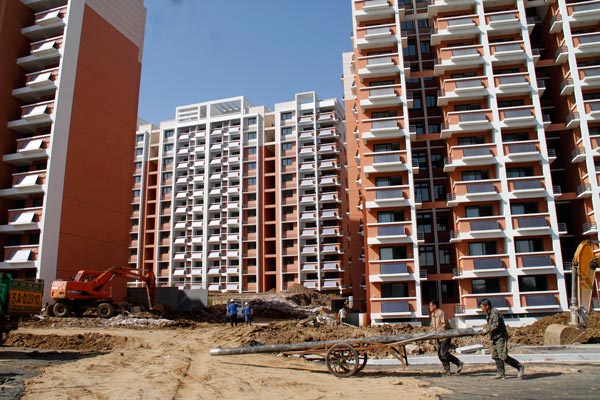Extending VAT reform can save $93b in 2016
Updated: 2016-02-17 13:51
By Zheng Yangpeng(chinadaily.com.cn)
|
|||||||||||
 |
|
A property construction site in Nanjing, capital of Jiangsu province. [Photo/China Daily] |
Shandong Gaishi Group, which runs the province's largest road cargo network, deals with over 12,000 vehicle shipment daily, with a total volume of 50,000 metric tons. To add its capacity, it last year borrowed loans that would require an annual interest payment of 30 million yuan($4.6 million). Under China's value-added tax reform, which was to replace business tax in the service sectors with VAT to avoid repeated taxation, Gaishi's interest payment eligible for deduction alone would save the company 1.7 million yuan of tax payment.
"The 1.7 million yuan could be used to buy 10 vehicles to expand our capacity. Without the VAT tax reform, we would have to think again whether to borrow," said Chai Shanshan, a tax planning director of the group.
The case illustrates the economic rationale behind policymakers' effort to cut corporate tax: less tax burden would free up more enterprises' earnings, thus inspire them to use that for capital expenditure. The rise in investment would offer a larger base to tax.
"It is a trade-off between short-term tax losses and long-term gain," said Liu Shangxi, director of the Fiscal Sciences Research Institute under Ministry of Finance. "In the long run it is also beneficial to the foster of new economic engines, upgrade of industries and consumption upgrading."
For now, the most talked about, and most feasible tax cut plan, is the VAT reform. Starting in 2012, the reform has so far expanded to all service sectors, such as transportation and telecommunication, which had in total saved 593.9 billion yuan of tax until the end of Nov, according to State Administration of Taxation (SAT).
In 2016, the reform is expected to expand to the four remaining bulwarks: property, construction, finance, and consumer services. If achieved, analysts said, it would be a remarkable progress. Business tax derived from the four sectors accounted for over two thirds of total business tax revenue. If replaced by VAT, it is estimated to reduce 396.9 billion yuan of tax on enterprises in these sectors, according to a report by People's Daily. Adding VAT reform in other sectors, 613.1 billion yuan would be saved in 2016.
What's more, the reform in the four sectors would bring benefits to their downstream industries, because VAT levied in these sectors would make downstream businesses more easier to get invoices to get deductions, said Hu Yijian, a tax professor at Shanghai University of Finance and Economics.
Economists also argued that the VAT rate should be simplified to lower the tax. Currently there are five VAT rate: 17,13,11,6 and 3 percent. Businesses are subjected to different rate according to their nature of business. China International Capital Corp suggested the highest rate could be lowered to 15 percent for manufacturing. If that's the case, 300 billion yuan tax would be saved.
A top meeting in December has proposed various ways to lower business cost, including "lowering VAT rate for manufacturing sector". The meeting did not specify how the tax rate would be lowered.
Besides VAT reform, China in the last year has also implemented various measures to cut tax for small and micro firms. In August the State Council decided to further eased the threshold of eligible firms to enjoy a 50 percent reduction in their corporate income tax. It also extended the exemption of VAT and business tax for small businesses with less than 30,000 yuan in monthly sales.
These policies have saved small and micro firms nearly 100 billion yuan of tax. Tax cut on high-tech companies relieved another 140 billion yuan of tax, according to SAT.
Today's Top News
Sichuan opera proves a hit with UK audiences
WeChat to charge fees for digital wallet transfers
Stocks fall in China after holiday week
Putin, Obama discuss Syrian crisis over phone
Global stock swings not caused by China factors
Russian PM warns against 'new cold war' at MSC
Einstein's gravitational waves detected
As Chinese celebrate, rest of world benefits
Hot Topics
Lunar probe , China growth forecasts, Emission rules get tougher, China seen through 'colored lens', International board,
Editor's Picks

|

|

|

|

|

|






